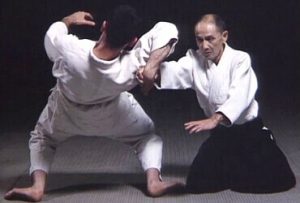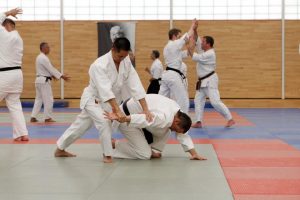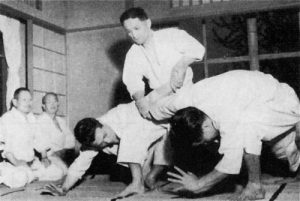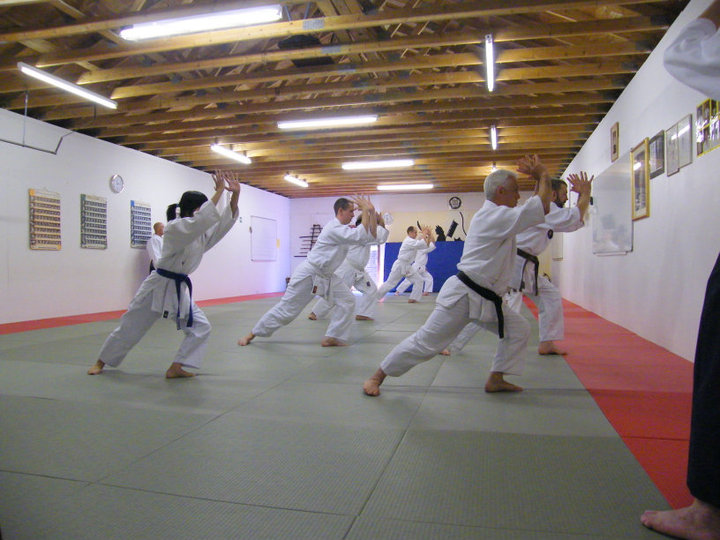ON THIS PAGE :-
1. Yoshinkan Aikido – Principles & Training Regime
2. A Little Yoshinkan History
3. A Technical Guide to the Kihon Dosa (Basic Movements)
1. YOSHINKAN AIKIDO: PRINCIPLES & TRAINING REGIME
 Kancho Gozo Shioda
Kancho Gozo Shioda“A Highly Structured System based on clear Principles”
Gozo Shioda was uchi-deshi at Aikido founder, Morihei Ueshiba’s kobukan dojo (nickname – “hell dojo”) during the 1930’s and early 40’s. Shioda stated that his Yoshinkan Aikido style was a faithfull rendering of the Aiki Budo that Ueshiba taught at that time, when he was reputedly at his technical peak.
Shioda sensei however, wanted more structure and consistency in the training process, so he created a logical and highly structured method in which beginning students would learn the foundation principles of aikido by constant repetition of clearly defined forms. This emphasis placed on correct form in the early stages rather than flow and timing is the trademark of Yoshinkan and contributes to the Yoshinkans image as a “hard” style.

Yoshinkan kamae
“Training to Build an Aiki Body”
Yoshinkan training begins with the training of posture or kamae. Important principles include ground connection, hip alignment and maintaining of a strong centre line.
Movement involves keeping the hips low and aligned perpendicular to the line of movement. The front knee is kept flexed and the rear straight, positive contact is maintained with the ground. The driving force of this movement is all from the lower body, the larger muscles of the legs and buttocks whilst the koshi (hips), becomes the driver, controlling power distribution and direction.
Much emphasis is placed on maintaining a unified body (zentai). To facilitate this the pelvis is slightly rotated forwards producing a concavity in the lower back and sets up a tension which maintains a connection between upper and lower bodies whilst simultaneously pushing the hara forwards to increase the feeling of centredness.
In order to transmit this unified body power (zentai ryoku) through the arms an unbending arm is maintained at all times, with elbows kept down facing and the armpits closed to maintain connection with the body.
A fundamental principle of the Yoshinkan system, and a very pragmatic one, is that one must learn to control ones self before controlling an opponent. Students therefore progress from the solo exercises of basic kamae and kihon dosa (basic movements) to paired kihon waza (highly structured basic techniques in kata form) and then on to more advanced applications and jiyu waza.
Along with kamae(basic stance), there are 6 “kihon dosa” or basic movements which are considered to be the building blocks of the 150 or so basic techniques. Yoshinkan aikido students practice these repeatedly to understand how to move their kamae around to put themselves in a strong position and to maintain a centred and unified body. Without proper form in one’s basic movements one’s aikido will not be effective. By maintaining a strong centred kamae throughout the phases of a technique one cultivates chushin ryoku (centre power) which with experience and mastery of timing and distance develops into kokyu ryoku or breath power, the ultimate aim of Yoshinkan Aikido.
Solo ” kihon dosa”
Emphasis on “Kata”
The basic techniques of the Yoshinkan are actually kata in the traditional sense of the word, a series of predetermined movements for both sh’te and uke. Whilst the waza are based on sound aikido principles they do not necessarily represent the most efficient method of applying a given technique, rather they are designed to further develop strong kamae, balanced movement , timing and correct distance. The kihon waza contain definite repeating patterns of movement which are essentially the kihon dosa movements. Hence the system is self reinforcing and sustaining.
In Yoshinkan kihon waza, the relationship between uke and sh’te is quite unique since there is no competition involved, instead the respective roles are used to promote mutual learning, to develop harmony and strong, correct technique.

Kihon waza
Advanced Practice
Students progress from Kihon waza (both tachi and suwari) to Oyo waza (advanced or applied techniques), Jiyu Waza (freeform techniques) and Goshin waza (practical applications). Whilst weapons techniques are practiced there is minimal content within the basic grading syllabus and Bukiwaza is considered more an adjunct to open hand technique, though some Yoshinkan schools have incorporated either Iwama style buki-waza or another style of kenjutsu/jojutsu .
Tsutomu Chida sensei, former head of Yoshinkans Hombu dojo in Tokyo, describes the progression in Yoshinkan aikido as follows: “In the beginning, Yoshinkan is sort of hard and stiff; because of this, it looks like guys are really attacking each other, but this is just the first level.” He adds that Yoshinkan follows the teachings of O’sensei in his use of the analogy of the progression from solid ice (physical), to water’s ethereal fluidity and eventually to air, whose near intangibility transcends the baser elements. But there are no short cuts. Ice cannot evaporate into air without first melting into water, as it were, via a trial by fire.
It is said that while other aikido schools focus more on finding an opponent’s weakness or on blending movements, Yoshinkan focuses more on making sh’te,( the doer of the technique), strong and balanced, yet still relaxed. It has been said that Yoshinkan aikido, rather than being a “style” of aikido, is really just a training method, and it is generally recognised that in the advanced stages all aikido styles merge to become one Budo.
2. A LITTLE YOSHINKAN HISTORY – EARLY DAYS
 Shioda Gozo in the late 1950’s
Shioda Gozo in the late 1950’s
Many who have been brought up within the Aikikai system consider Yoshinkan Aikido as a “poorer cousin” because of its lesser status in numerical terms compared with the Aikikai organization. What is overlooked is the fact that it was Gozo Shioda and his close associates very much took the lead in reviving aikido after the war.
Shioda was one of the founder’s early students who enrolled at the Kobukan Dojo in 1932. He spent eight years studying prewar “aiki budo” before becoming involved in the war in a civilian capacity, spending most of these years in Southeast Asia and China. In 1946, a few months after his discharge from the Imperial Army, Shioda spent several weeks of intensive training and farming at the home of Ueshiba in Iwama. Still a young man and with his teacher in retirement, Shioda then returned to Tokyo and like most others struggled to make ends meet in poverty-stricken Japan.
In 1950, as fate would have it, Shioda was asked to guard the Tsurumi facility of the Nihon Kokan steel company in the wake of the “Red Purge”, an anti-Communist movement led by General MacArthur to stifle the influence of the powerful Japanese trade unions. Shioda gathered together some 55 of the strongest members of the kendo, judo, and sumo clubs from Takushoku University, to serve as a security force. This led to him being asked to teach aikido on a regular basis at various plant locations starting in 1952. Shioda also gave demonstrations at numerous police departments in the early 1950s.
In 1954, Shioda participated in a large aikido demonstration held in Tokyo, sponsored by the Life Extension Association, and attended by some 15,000 people. Morihei Ueshiba was scheduled to appear in this demonstration but was unable to attend due to illness and instead Koichi Tohei represented the Aikikai.
Shioda’s performance received a favourable reception from the huge audience and little by little the nascent Yoshinkan group began to achieve prominence. Also, around this time, Shioda’s activities became known to various members of the business world, in particular, Shoshiro Kudo head the Tomin Bank, who came to the aid of the Yoshinkan and backed the construction of their first dojo. The Tsukudo Hachiman facility was opened to the general public in 1955.
It is quite revealing to look at group photos from the early to mid-1950s and see faces associated with other aikido organizations appearing alongside Aikikai instructors. For example, Shioda, and his senior students Terada, Tanaka, and Matsuo, can be seen together with Kisshomaru, Tohei, Saito, Arikawa, Tada, Yamaguchi and Nishio, not to mention Kenji Tomiki.
 Late 1950’s aikido gathering
Late 1950’s aikido gathering
Before 1955 when the Yoshinkan formally started, active practitioners of aikido formed a loose brotherhood where virtually no organizational boundaries existed. As circumstances would have it, Shioda was able to build his core group and achieve financial backing at a time when the Aikikai was still struggling with its first tentative steps.
After the establishment of the Yoshinkan, the Aikikai remained very conscious of its progress. In fact, it could be said that something of a “friendly rivalry” existed. For example, the Aikikai adopted the practice of accelerating dan promotions in order to match the ranking levels of Shioda’s instructors. Several well-known Aikikai instructors skipped dan rankings in order to achieve a par with the Yoshinkan including Morihiro Saito Sensei who stated that he skipped two dan ranking levels during the 1950s.
3. A TECHNICAL GUIDE TO THE KIHON DOSA (BASIC MOVEMENTS)





 Kancho Gozo Shioda
Kancho Gozo Shioda Yoshinkan kamae
Yoshinkan kamae
 Kihon waza
Kihon waza Shioda Gozo in the late 1950’s
Shioda Gozo in the late 1950’s Late 1950’s aikido gathering
Late 1950’s aikido gathering




